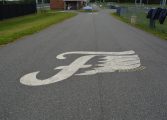“I first became intrigued about curling while watching late night coverage of the 2006 Olympics. Years later, when I first moved to the Charlottesville area, I was looking for new activities to try, and ways to meet people. I saw a news story about curling in Charlottesville and thought ‘I’d love to do that,’” said Melissa Cawley – known as Mel to her teammates. Cawley’s teammate Kaite McCartney was also looking for something to do on a weekday.
Cawley discovered that not only was the game interesting and fun but it also attracts a wide variety of people.
“There is a community feel to the sport that radiates beyond the local clubs. I love traveling to other clubs to participate in their events, and meeting fellow curlers,” Cawley said.
McCartney added, “I love how welcoming curlers are to new players. The game is challenging, but we are good at leaving the competitiveness on the ice. There is a long-standing tradition of the winning team buying a round of drinks for the losers, so either way you win, right?”
In recent years, its popularity has grown and in the U.S. alone there are 165 curling clubs and 16,500 curlers. The 2006 U.S. Olympic team is credited with spotlighting the game by winning a bronze medal.
This strange sport, developed during the rugged Scottish winters, is played on ice – known as the curling sheet- with two teams of four each, pushing heavy granite stones (rocks) toward a target (the house). It looks like a combination of the Italian bocce ball and bowling on ice. It takes strength and precision to master the sport of curling.
“The strategy is more complex and the play more physically demanding than most people realize,” said Cawley.
“I find the most challenging thing to be your own progress,” said McCartney. “In a place where curling is still new, and there aren’t a lot of experienced players, it takes a lot of dedication to improve your own game.’
They play on two primary teams – a social team that plays at the Main Street Arena in Charlottesville, and a competitive team that travels to tournaments.
They recently participated in the U.S. Curling Arena National Championships with the Curling Club of Virginia – based in Richmond – making it all the way to the quarterfinals. Cawley and McCartney said that this event is considered the national finals for teams that play on “arena ice,” or ice that is shared with other sports.
“Arena curlers are the fastest growing group in the sport. Recently Blue Ridge Curling Club – based in Charlottesville – was created and just admitted into the Grand National Curling Club, making us a part of the official national curling organization,” said Cawley.




